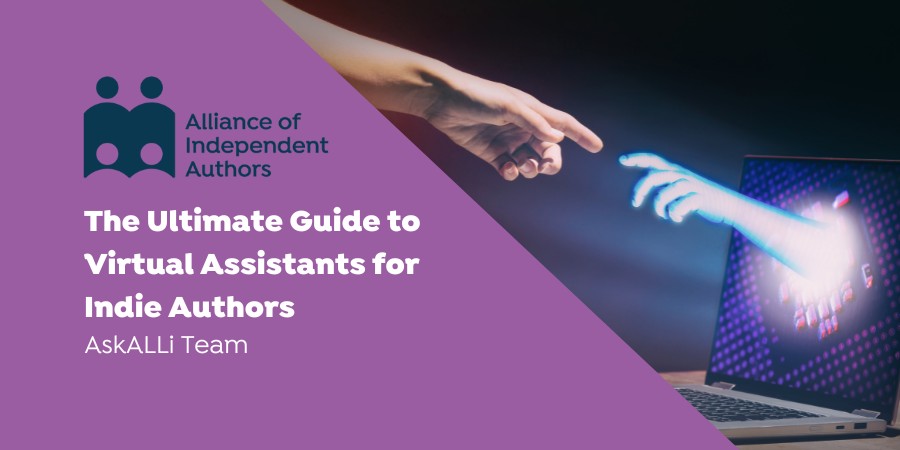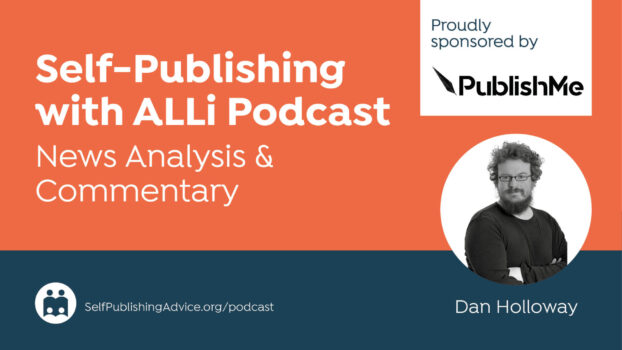For some writers, it's because they can't keep up with the work. Others budget it in from the start. But sooner or later a working self-publisher needs a virtual assistant. Today, the Alliance of Independent Authors AskALLi team is looking at the latter. This is the ultimate guide to outsourcing and working with virtual assistants for indie authors.
Outsourcing: An Introduction
For writers who have spent most their business life working solo, the thought of hiring a virtual assistant can feel overwhelming. We relish the control we have over our work and output. It's scary to hand work off. But there comes a point where if you want to continue to grow your income, you need to outsource some aspects of your work.
One method for justifying the outsourcing is to understand the cost of your time on a per hour basis. If you earn roughly $40 an hour in your business, but the cost of a VA is only $15 or $20, then financially it makes sense to offload tasks that are administrative, so that most of your time gets spent on creation and strategy.
The more you create, the more products and books you have to sell. The better you strategise, the more products and books you shift. All of this increases your income. The balance is to ensure that you don't spend more than you make.

Orna Ross, Director of ALLi
When Should You Outsource?
Orna Says:
In my experience, most authors do it when they come to the point of having too much to do, and not enough time to do it. Others–those who've run other businesses, or are more businesslike by nature–know their needs in advance, and start as they mean to continue.
When I started my author publishing business, I muddled along by myself for a little while but then Philip and I founded ALLi, and started with a team in place. And as ALLi grew, I quickly needed a team on the publishing side too.
Sacha says:
Sacha Black, ALLi Blog Manager
I've been in business since 2017, but I've only been working for myself since 2019 (three years as I type this). So I'm still a relatively new business owner. Despite that, I got to the point where the admin involved in keeping the business running was far outweighing the amount of time I had to write and create. That wasn't a position I wanted to be in. And the pandemic compounded that because I had my little one at home needing homeschooling. There physically weren't enough hours in the day. So it felt like the right time to outsource. If it weren't for the pandemic, I may have waited a little longer, by my principle is to outsource when the admin involved in keeping my company going impacts writing and creating time.
What that meant, was a short term financial drop. I had to outsource—which cost money—in order to gain my time back. Time that I would ultimately use to create more assets that would bring me more income. But assets take time to create. In the short term, that meant an added financial pressure. Despite that, after a few short months (I think less than three) I was already making back the money I was spending and more. So I continued upping my VA hours to the point where I now use an entire working week of her time each month.
If I'm honest, this is probably a little higher than I'm financially comfortable with. However, as a working mom to an eight-year-old, my time is scarce. The pandemic taught me that so many life things can get in the way and take my precious time. This is my way of protecting as much of that time as possible. I'm not afraid to ask for help or outsource, because the more time I keep for creating the faster I can grow my income.”
What Should You Outsource?
Orna Says:
Everything that you don't want to do, or that somebody else can do better than you. When you come to the point of having too much work to do, you essentially have three choices: defer, delete or delegate. TRY THIS: Sit down with the full list of all the processes in your writing and publishing business. There are some things only you can do. Keep these, obviously. There are some things you love to do. Keep these, also. Everything else should be outsourced.
Understanding what needs to be done is only the first part of the job. Equally challenging is finding the right people to do it. Ideally you want to hire as few people as possible but you want to pick people who are experienced and expert at what they do.
Sacha Says:
I outsource a raft of things. There are a few things that only I can do: writing books, creating courses, recording podcast interviews. Everything else doesn't have to be done by me. My stance is that everything other than those items mentioned, has the potential to be outsourced.
Here are a few ideas:
- Scheduling social media posts
- Creating social media graphics
- Setting up mailing list emails, gathering links and creating images
- Podcast admin, creating graphics, scheduling and uploading audio and images, leasing with guests
- Uploading publishing files
- Applying for regular book promotion newsletters
- Researching various topics
- Completing spreadsheets and tracking performance
- Pitching influencers
- Pitching rights buyers
Setting Up Systems with a Virtual Assistant
Establishing a system of how work is assigned, tracked and completed is really important to ensure all work and payments are transparent. Depending on the complexity and quantity of work given, you may require a simpler or more complex system.
Orna Says:
- Process Document – this is the most important document, to my mind. I'm trying to get to the point where we have documented every process in ALLi and Orna Ross Publications. It's hugely helpful to the team and also if we bring in someone new (see onboarding!)
- File Sharing – We use both Dropbox and Google Drive as they each have different strengths and weaknesses.
- Project Management – For larger projects, and timelines, we use Asana to organise tasks, hold each other accountable, and keep deadlines (or at least know when we haven't met them!)
- Onboarding — Your assistant needs a clear understanding of what your business stands for, the goals you have for it, and the processes already in place. A good onboarding process plays a key role in your virtual assistant's success and in ensuring that you both have a smooth settling-in period. It may feel like you don't have time to do this well but time spent on onboarding saves many hours later. An onboarding checklist that introduces your VA to key parts of the business (you can use that again for others) and their work is a useful tool, well worth developing.
Sacha Says:
One of the best things I ever did with my VA was to have a zoom meeting where I screen recorded everything. I took her through all the back end podcast tasks and showed her step by step what setting up an episode was like and how to do the other tasks. I then sent the video to her to use for reference later. This meant she always had something to check back on if she forgot how to do something.
I've never quite got my head around Asana or workflow systems, so I use a Google spreadsheet to keep track of most tasks. I assign dates for completion, highlight priorities and any connecting work I may have to do to enable my VA to do their tasks. We then use various other documents to keep track of project specific work.
I also use a Google drive folder system for work and various documents. Last, we use WhatsApp to communicate and let each other know things are done. I receive a PDF invoice via email and payments are made through Wise.
My VA has access to my podcast email account so we agreed standard responses/template emails for most of the regular enquiries. I kept the email on my computer for a while, but we've had a long enough working relationship that I've taken it off completely. Anything she's unsure about she forwards on.
We also use Canva, templates are shared, I have a color palette and brand guidelines and that enables her to make images that I love more or less first time every time.
When Things Go Wrong with a Virtual Assistant
Things can go wrong for many reasons. It might be you! Perhaps you’re not letting things go and insisting on micromanaging or the opposite, not communicating properly. A good VA hates to double book you, waste your time or theirs, or mess up a job. So help them to help you (See below for more on how to be a good client).
Or sometimes it might be them. They're slapdash, don't deliver as requested, miss deadlines… whatever. You've put the time in and given them a good onboarding and training but it's still taking longer to get the work out of them then if you were to do it yourself. Often, it's a mix of the two. Poor communication lies at the heart of most poor VA behaviour.
VAs need direction; they need to know what you want to be done, and they're going to have questions if they are to do what you want and how you want it. They need to communicate with you to work with you so be available. Reply to emails or texts. If you're going to be in your writing cave, let them know when, and when you'll be out. You can easily lose intention, context and meaning in texts or email. Sometimes a call or video chat can solve a problem. Can you improve your communication? Have you truly done all you can? Or are you getting irritated and emotional?
Some writers live constantly in crisis mode, for example. Yes, we may have tight deadlines but if every project is a last-minute emergency, working relations will soon be strained. Allow for an appropriate amount of time for work to be completed.
Don't “hire a virtual assistant to work 10 hours per week, but expect them to be available for you 24/7 at a moment’s notice,” says Jess Tyson, CEO & Director of Calm at Don't Panic Management and author of Panic Proof: How the Right Virtual Assistant Can Save Your Sanity and Grow Your Business. “Even if only 10 hours of projects come up, tuning into your needs all day, every day is more than a full-time job [for your assistant].
“Your assistant is balancing work for other clients (probably), personal responsibilities (definitely), and a social life (hopefully), in addition to watching out for your assignments. If you email something to your 10-hour assistant and don’t hear back for several hours, that’s normal—and it’s fair considering the contract.”
If things have started to go wrong with your assistant, open up the lines of communication and invite constructive criticism. Don't shoot yourself in the foot by firing off. It's easier and less time-consuming to improve your communication and processes with somebody you've already put a lot of time into than to turn around and start over.
But sometimes it's just not a fit and there's only one thing for it. With the hiring responsibility comes the firing responsibility. Sometimes an assistant may let you go, other times you may need to let them go. Reasons can be many and might include:
- The VA is not meeting their obligations or doing the work as agreed
- Their work is done but in ways that are detrimental to your business e.g. taking too long or you need to chase too much.
- They are taking too much time off or are unavailable for other reasons
Alternatively, your circumstances or business dynamics may change, causing a parting.
How to Let A VA Go
First of all, depending how integrated your VA is in your business, there are some areas of your business you need to protect, and tasks you should complete as your outsourcing comes to an end.
- Back up your work and project files in a place only you have access to digitally
- Revoke access to systems, change passwords
- If you're on good terms with the VA you'll need to decide and agree an exit strategy. Note that if you've agreed contractually to end at the end of a month and it's still the beginning of the month, you should meet your contractual obligations and maintain your integrity as a business contracting freelancers
- Request any handover information or updates you need
- Pay the final invoice promptly
- Leave any appropriate feedback
If things end badly, or they become awkward, it makes ending a relationship a little bit harder and more nuanced. First of all, as mentioned above, you should always adhere to whatever contractual obligations you've agreed upon. This means the VA will be paid what they're owed and you maintain your business integrity and any feedback the VA could leave is more likely to be positive.
But what else should you consider?
Don't write or send a termination letter or email too quickly. Have a friend read it over. Sleep on it. But whatever you do, don't send it angry. You might also consider sending a warning email first, before cutting ties instantly. Have you given them enough feedback and time post feedback to rectify the situation? Do they feel your assessment of the situation is fair?
You need to be clear and concise in your termination letter without writing anything personal. Keep your phrasing neutral and to business or facts. Refer to previous correspondences, times, dates and agreements, in particular where those agreements have not been met.
Ending a working relationship is never fun for anyone involved. Consider saying something positive in your termination email (as long as it's also true). It's a more positive note to leave the relationship and while it might not remove all the animosity, it's a little kinder.
It might also be worth checking your local government websites for information on dismissing someone. Even if you don't employ a full-time employee, it's both respectful, and honorable to ensure you end things with contracted freelancers in an appropriate way. Furthermore, each country will have their own set of rules
Ending Services Template
Dear XYZI’m writing to inform you that I will no longer be needing your services as I move forward with writing and publishing. Your contract with me will expire—as agreed in our contract—at the end of the current contractual month. This means your final date of work with me is July 31st, 2022.While I appreciate the work you have done, and the services you have provided me, I don’t think this is the best fit for my business. I do however, think your graphic skills and scheduling work have been exemplary and I am grateful for the work you’ve done.Please take note that you should send your final invoice promptly after the 31st July, and as contractually agreed, all monies owed to you will be paid within one week of receipt of the invoice.Should you have any queries, please contract me on [insert contact details].Thank you for your understanding, I wish you all the best of luck for the future.RegardsAuthor Name

Kayleigh Brindley, SelfPubCon Conference Manager and experienced VA
What Makes a Good Author Client?
The AskALLi team asked Kayleigh Brindley, SelfPubCon conference manager and experienced virtual assistant some key questions about working with authors.
Q1. What makes a good author client?
A good author client is someone who knows what support they need. They should have ideally gone through the self-publishing process at least once, so they know the ins and outs of producing and promoting a book and are clear about what tasks they most need help with. This allow the author to provide a clear brief, and any necessary instructions.
The author should also be ready and willing to add a new team member to their author business. This means that they’re ready to co-operate, relinquish some control over certain aspects, and allow the VA to bring their expertise to the author’s business.
Q2. What things do you wish authors would tell you? Or what information do you need from authors?
My advice to authors contacting a VA for the first time is to be specific about what you need. Don’t just send a blanket email saying, ‘I need help to build my author profile and selling more books.’ It’s not enough information for a VA to provide an accurate quote, and emails like this will result in a lot of back and forth between you and all the VAs you contact as they aim to get a clear picture of what you want them to do.
Instead of saying, ‘I need help building my author profile and selling more books’ say, ‘I need help creating graphics to promote my books on social media’ or ‘I need someone to write and format monthly newsletters to help engage my mailing list.’
Before you contact the VA, it’s important that you know what approach you want to take i.e. don’t ask for help with social media if you don’t have a clear picture of the strategy you want to take and the platforms you want to focus on. A VA will need clearer direction of what you want before they can help.
Also include any deadlines your VA needs to be aware of, and what your goals/expectations are. If you want to work with a VA who has a specific skillset or experience i.e. you want a VA who’s familiar with Vellum, be sure to mention it in your first email to them. It’ll save time when trying to find a VA who’s a good fit for you.
So, be specific, but to the point. There’s no need to include your entire backstory or the plot of your books, but tell them what genres you write in (so they can let you know if there’s a certain genre they can’t work with). A shorter, straight to the point email is always the best initial approach to help you find the VA who best meets your requirements.
Q3. What are the best systems and processes for working with a VA
The systems you need will vary depending on what you want a VA to help you with, but there are some basics that you’ll likely need to have in place before working with your first VA.
- Process Document – this should contain all of the login information and links to the programs you use that your VA will need access to. It should include your author bio, links to your books and any other information relevant to the work your VA will be undertaking.
- Password Sharing – while most emails are encrypted during transmission, it can be reassuring for authors to use a password sharing service, such as LastPass to help keep all login information secure, whilst giving their VA access to relevant programs and software.
- File Sharing – you’ll likely need to share files, including your process document, with your VA so setting up a core folder in Dropbox or GoogleDrive can help to keep you organised.
- Project Management – if you’re working on a large project with your VA – like managing your next book launch – you might want to consider a project management tool. Apps and tools like Asana and Trello can help to give you and your VA a central location to organise tasks, hold each other accountable, and to keep deadlines and deliverables clear for everyone involved.
Q4. What mistakes or lessons have you learned over the years from working with authors?
Always do a trial piece of work or a trial period before committing to any long-term projects. This works in favour of both the author and the VA by ensuring that you can communicate and work well together. A trial period can also help to reveal any gaps or issues in the initial brief. For example, some tasks can take longer than expected, and a trial period allows the VA to explain any cost or time changes to the author before signing up to a longer contract.
Stick to email for most conversations, or ask your VA to provide a summary after a call. This ensures that both the author and VA have a copy of what was discussed and agreed upon, are aware of who’s responsible for certain tasks, and so that discussions and agreements on tasks and deliverables can be tracked.
How to Find a Virtual Assistant: ALLi Authorpreneur Members
We spoke to some of the ALLi Authorpreneur members to understand their experiences of working with virtual assistants. We asked three questions
-
Where or how did you find your VA?
-
What do you outsource?
-
One tip or bit of advice for someone looking to work with a VA?
Brian Chang
- I found my VA on onlinejobs.ph
- A little bit of everything, formatting, updating website.
- A small interview test is a must. That helps to identify the best talent.
- My community — I asked my podcast audience and Alexandra replied and we've been working together for many years now (and have never met and only rarely speak!)
- Podcast transcription editing; some email including the public inbox full of basic questions from people not on my email list, so she filters those, and also any email that doesn't need my personal response; updating book links and website pages and other random tasks as they come up along the way
I found my VA through Pink Sgaghetti who have a kind of hybrid semi-virtual model. They assign you a VA in your area which means if you need to meet up or have them come to your office, you can. But if you want, it can all be virtual. They also have teams of specialists in things like marketing, websites etc. who the VA will bring in if needed. So far I'm loving the flexibility of a VA mixed with the extra trust that comes from being able to meet. Jayne has kept my business ticking over when I've been ill or travelling and it's been invaluable.
My USA assistant runs my ARCs and manages social for my pen name. I knew her online before she became my assistant. She keeps me up to date and is invaluable.My daughter works for me part time and does tech for my Shopify store (which is my website too) plus my pen name's site. She answers non-personal emails, does the initial proofreading, finds images, and does anything I need on InDesign and Photoshop. She does all sorts of things.






Really helpful guide, thank you: I’ll share it with my audience as several of them have asked me about this.
I’ve only worked a little with a VA so far and I’m always amazed by how much she gets done in the time spent. I also try to remember Orna’s advice to “delete” tasks, instead of assuming I need to outsource something.
Oh yeah! My favorite button (after “Publish”) is “Delete”! Thank you for sharing Pauline.
Thank you for the article. I wonder if you can comment on a small detail of some of the uses for a VA. At the start you mentioned among other uses, Applying for regular book promotion newsletters, and Pitching influencers. Have you asked a VA to do either one of those tasks, and what is a reasonable rate of pay for the VA to find the targets, i.e. newsletters and influencers? Thank you in advance.
Hi David, yes I have. I find most VAs work on a per hour basis and that’s the best basis for tasks like this, I believe.
I and my fellow US VA friends charge $35 to $80 per hour. At the lower end, it’s admin tasks only. At the higher end, you can get website work, email marketing strategy, social media strategy, creation AND management.